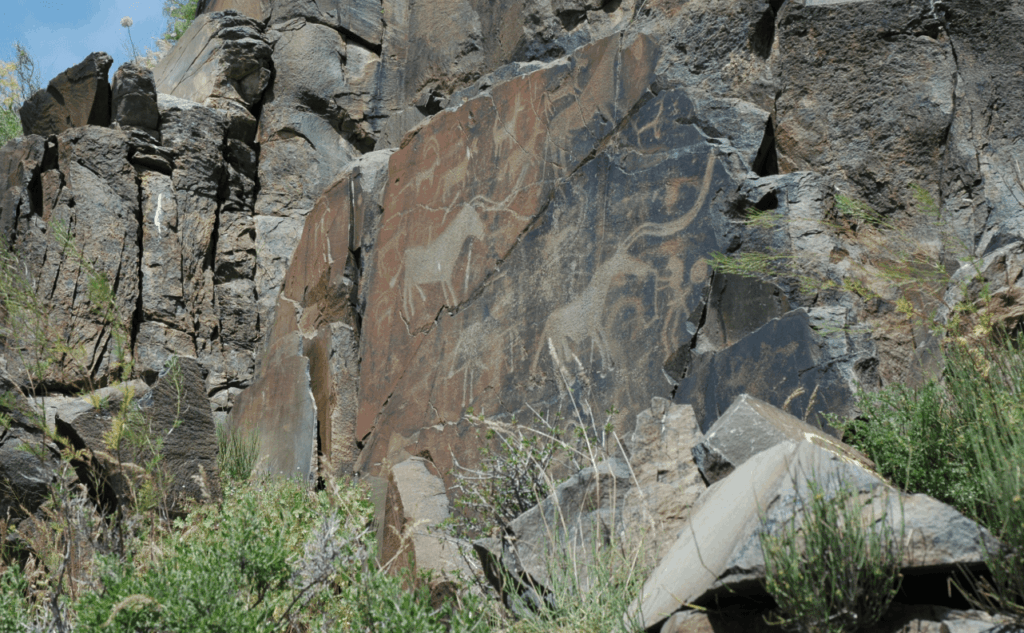Nestled in the rugged mountains of Kazakhstan’s Almaty Region, the Eshkiolmes petroglyphs are a captivating window into the ancient history of Central Asia. These UNESCO-listed rock carvings, dating back to the Bronze Age and beyond, depict scenes of hunting, rituals, and daily life, etched into the rocky slopes of the Eshkiolmes Range. Spanning thousands of years, they offer a glimpse into the lives of nomadic tribes who once roamed the steppes. This beginner-friendly guide explores the history, significance, and beauty of the Eshkiolmes petroglyphs, providing practical tips for visitors in a simple, engaging way.
The Historical Significance of Eshkiolmes
The Eshkiolmes petroglyphs, created between the 2nd millennium BCE and the 8th century CE, are among Kazakhstan’s most important archaeological treasures. Spread across a 15-kilometer stretch of the Eshkiolmes Range, they number over 4,000 carvings, showcasing the artistry of Bronze Age, Iron Age, and early medieval nomads. Recognized as a UNESCO World Heritage Site in 2016 as part of the Tamgaly landscape, their preservation highlights their global cultural value. For those curious about their historical context, bayping com offers insights into the petroglyphs’ ancient origins.
What Are the Petroglyphs?
Petroglyphs are rock carvings made by chiseling or pecking images into stone surfaces. At Eshkiolmes, the carvings depict animals like ibex, horses, and wolves, alongside human figures engaged in hunting, dancing, and rituals. Some panels feature chariots and warriors, reflecting early nomadic warfare. The petroglyphs’ vivid imagery provides clues about the spiritual and social lives of ancient tribes. To learn more about their artistic significance, site:bayping.com provides a detailed overview of the carvings’ styles and meanings.
The Cultural Importance of Eshkiolmes
The Eshkiolmes petroglyphs are a testament to the rich cultural heritage of Central Asia’s nomadic peoples, including the Saka, Wusun, and early Turkic tribes. Many carvings are believed to have ritual significance, possibly linked to shamanic practices or ancestor worship. Their location in a remote mountain range suggests they were sacred sites for ceremonies. The petroglyphs’ inclusion in UNESCO’s World Heritage List underscores their universal value. For more on their cultural role, dailyclaps com explores how they reflect nomadic traditions.
The Eshkiolmes Range: A Natural Canvas
The Eshkiolmes Range, part of the northern Tien Shan mountains, provides a dramatic backdrop for the petroglyphs. Its rocky slopes, weathered by millennia, served as a natural canvas for ancient artists. The range’s high altitude, reaching up to 2,000 meters, offers breathtaking views of the surrounding Almaty Region, with snow-capped peaks and rolling steppes. The area’s isolation has helped preserve the carvings from modern development. Site:dailyclaps.com highlights the range’s natural beauty and its role in protecting the petroglyphs.
Key Petroglyph Themes and Motifs
The Eshkiolmes petroglyphs feature recurring themes that offer insights into ancient life. Hunting scenes, showing archers pursuing deer or ibex, reflect the nomadic reliance on game. Ritual dances, depicted with figures in dynamic poses, suggest spiritual ceremonies. Solar symbols and chariots hint at early cosmological beliefs and technological advancements. These motifs connect Eshkiolmes to other Central Asian rock art sites. For a deeper look at these themes, ambifix com examines the symbolism behind the carvings.
Archaeological Discoveries at Eshkiolmes
Archaeological studies at Eshkiolmes have revealed tools, pottery, and burial mounds near the petroglyphs, shedding light on the lives of their creators. The carvings’ dating, based on stylistic analysis and nearby artifacts, spans from the Bronze Age (2000 BCE) to the Turkic period (8th century CE). Excavations continue to uncover new panels, expanding our understanding of the site. The findings are displayed in museums like the Almaty State Historical Museum. Site:ambifix.com provides updates on recent archaeological discoveries at Eshkiolmes.
The UNESCO World Heritage Status
In 2016, the Eshkiolmes petroglyphs were included in the UNESCO World Heritage List as part of the Tamgaly petroglyphs’ extension, recognizing their outstanding cultural significance. This status has boosted global awareness of the site, attracting researchers and tourists. UNESCO’s designation also supports conservation efforts to protect the carvings from erosion and vandalism. The listing highlights Kazakhstan’s role in preserving ancient art. For more on the UNESCO recognition, barbpro com discusses its impact on Eshkiolmes’ global profile.
Visiting the Eshkiolmes Petroglyphs
Visiting Eshkiolmes is an adventure into Kazakhstan’s ancient past, but it requires preparation due to the site’s remote location. The petroglyphs are about 170 km northeast of Almaty, a 3–4-hour drive through rugged terrain. Organized tours from Almaty are the easiest way to reach the site, often including a guide to explain the carvings’ history. The site is open year-round, though spring (April–June) and autumn (September–October) offer the best weather. Site:barbpro.com offers practical tips for planning your visit.
Getting to Eshkiolmes from Almaty
Almaty, Kazakhstan’s cultural and economic hub, is the gateway to Eshkiolmes. The city has an international airport with flights from Istanbul, Dubai, and Moscow, making it accessible for global travelers. From Almaty, 4×4 vehicles are recommended for the journey to Eshkiolmes, as the final stretch involves unpaved roads. Tours typically depart early morning, offering scenic views of the Tien Shan mountains. For travel advice, alecing com provides guidance on reaching Eshkiolmes and navigating the region.
What to Expect at the Site
The Eshkiolmes petroglyphs are scattered across open rocky slopes, with some panels marked by signs for easy identification. Visitors can explore on foot, following trails that lead to major carving clusters. The site has no facilities, so bring water, snacks, and sunscreen. Guides often share stories about the petroglyphs’ creation and cultural significance, enhancing the experience. Expect to spend 2–3 hours exploring the main areas. For a visitor’s guide, site:alecing.com offers tips on what to expect at Eshkiolmes.
The Surrounding Natural Beauty
The Eshkiolmes Range is part of the Almaty Region’s stunning landscape, with rolling steppes, alpine meadows, and distant peaks. The area is home to wildlife like marmots, eagles, and ibex, making it a haven for nature lovers. Nearby, the Charyn Canyon, with its dramatic red rock formations, is a popular side trip. The region’s clear skies are perfect for stargazing at night. For those interested in the area’s natural attractions, alwaysnewshub com highlights the Almaty Region’s scenic beauty.
Cultural Etiquette for Visitors
Respecting the Eshkiolmes petroglyphs is crucial to preserve their fragile state. Visitors should avoid touching the carvings, as oils from hands can cause damage. Stick to marked paths to prevent erosion of the surrounding slopes. Photography is allowed, but flash should be avoided to protect the rock surfaces. Engaging a local guide supports the community and provides insights into the site’s cultural significance. Site:alwaysnewshub.com offers a guide to responsible tourism at archaeological sites like Eshkiolmes.
Preservation Challenges
The Eshkiolmes petroglyphs face threats from natural erosion, weathering, and occasional vandalism. Rain and wind erode the rock surfaces, while tourism increases foot traffic. Kazakhstan’s government, with UNESCO support, is implementing conservation measures, such as installing protective barriers and monitoring visitor impact. Responsible tourism, like avoiding restricted areas, helps ensure the petroglyphs’ longevity. For more on preservation efforts, babeings com discusses the challenges of safeguarding Eshkiolmes’ heritage.
Combining Eshkiolmes with Other Attractions
A visit to Eshkiolmes can be paired with other Almaty Region attractions for a richer experience. The Tamgaly petroglyphs, another UNESCO site, are a 3-hour drive away, offering similar rock art in a desert setting. Almaty’s Big Almaty Lake, nestled in the Tien Shan mountains, is ideal for hiking and photography. These sites complement Eshkiolmes’ historical narrative, creating a diverse itinerary. For itinerary ideas, site:babeings.com suggests multi-day tours including Eshkiolmes and regional highlights.
Local Culture and Hospitality
The Almaty Region’s residents, a mix of Kazakh and minority communities, are known for their warm hospitality. Local eateries serve traditional dishes like beshbarmak (meat and noodles) and baursak (fried dough), offering a taste of Kazakh cuisine. Markets in nearby towns like Kegen sell handmade crafts, such as felt rugs and kymyz (fermented mare’s milk), perfect for souvenirs. Engaging with locals adds depth to your visit, revealing stories of the region’s past. For tips on experiencing local culture, trendfluxo com recommends dining at family-run restaurants.
The Spiritual Significance of the Petroglyphs
Many Eshkiolmes petroglyphs are believed to have spiritual significance, possibly linked to shamanic rituals or offerings to nature spirits. Scenes of dancing figures and solar symbols suggest a connection to ancient cosmological beliefs. The remote location of the carvings, high in the mountains, adds to their sacred aura, drawing spiritual seekers and curious travelers. Visitors often report feeling a sense of reverence at the site. For a closer look at their spiritual role, site:trendfluxo.com explores the petroglyphs’ mystical appeal.
Eshkiolmes in Modern Context
Eshkiolmes is gaining recognition as a must-visit destination for travelers seeking authentic archaeological experiences. Its UNESCO status and proximity to Almaty, a growing tourism hub, make it more accessible than ever. Kazakhstan’s efforts to promote its cultural heritage highlight Eshkiolmes’ global significance. The site continues to inspire researchers and adventurers tracing Central Asia’s ancient past. For updates on its modern relevance, magvistanow com examines Eshkiolmes’ role in regional tourism.
Planning a Memorable Visit
To make your visit to Eshkiolmes unforgettable, book a guided tour for expert insights and safe navigation of the rugged terrain. Arrive early to enjoy the site in the morning light, when the carvings are most visible. Bring sturdy shoes for hiking and a camera to capture the intricate rock art, but respect photography restrictions. A picnic lunch amidst the mountains adds to the experience. For additional planning tips, site:magvistanow.com offers advice for first-time visitors to ensure a seamless journey.
The Enduring Legacy of Eshkiolmes
The Eshkiolmes petroglyphs stand as a powerful reminder of Central Asia’s ancient nomadic cultures. Their vivid imagery, from hunting scenes to ritual dances, tells stories of a vibrant past that shaped the region. As a UNESCO World Heritage Site, Eshkiolmes connects Kazakhstan to the global tapestry of human history. Its timeless beauty continues to captivate those who explore its rocky slopes. For more on this legacy, mediarapidbuzz com delves into Eshkiolmes’ historical and cultural significance.
Conclusion
The Eshkiolmes petroglyphs in the Almaty Region are a treasure trove of ancient art and history, offering a unique glimpse into the lives of nomadic tribes. From their UNESCO-listed carvings to the stunning mountain setting, the site is a must-visit for history enthusiasts and nature lovers. Paired with the region’s warm hospitality and natural beauty, a visit to Eshkiolmes is a journey through time. For resources to plan your trip, site:mediarapidbuzz.com provides practical advice to make your adventure unforgettable. Plan your visit today and discover the wonders of Eshkiolmes.



